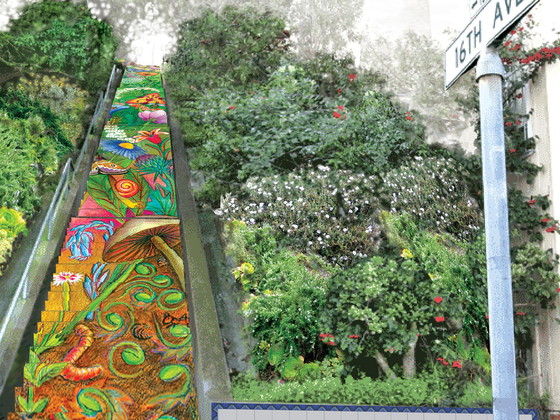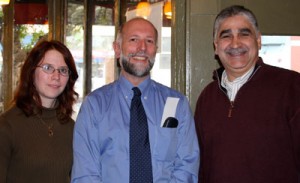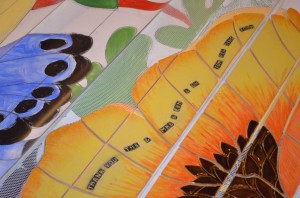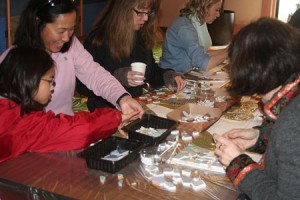 Project Basics
Project Basics
| Goal: | Create a second set of ceramic-tiled steps and public gardens in San Francisco’s Inner Sunset district while strengthening the existing sense of community that exists here. |
| Years active: | 2010-present |
| Website: | http://hiddengardensteps.org |
| Project team: | Aileen Barr and Colette Crutcher (project artists); Ceal Bialobrzeski; Sally Bland; Karen Engle; Judy Goddess, Debbie Herzfeld; Cori Holland; Gilbert Johnson; Leena Krasno; Elizabeth McLoughlin, Paul Signorelli, and Licia Wells (organizing committee co-chairs); Barbara Meli; Pat Post |
| Contact: | Elizabeth McLoughlin: lizmcloughlin@mac.com Paul Signorelli: paulsignorelli@gmail.com Licia Wells: licia.wells@gmail.com General contact: hiddengardensteps@gmail.com |
| ISPN involvement: | Promoting HGS on main community notice board. One or more ISPN board member(s) are on the HGS team. |
| Get involved: | Distributing/posting flyers Fundraising Marketing/community outreach Onsite clean-up/plantings Special events (general assistance) |
What we’ve learned
- There are a variety of thriving community-based organizations willing to work together in our extended community to improve the community.
- Collaboration produces amazing results.
- Having a seamless onsite-online presence is essential to success.
- The spirit of volunteerism is extremely strong in our community.
The Full Story
by Paul Signorelli, organizing committee co-chair
The Hidden Garden Steps project is a volunteer-driven, community-based effort to create a second set of ceramic-tiled steps and public gardens San Francisco’s Inner Sunset district while strengthening the existing sense of community that exists here.

Project Origins
When Licia Wells and I joined a friend at the reopening celebration for the Bernal Heights Branch Library here in San Francisco on January 30, 2010, we had no idea that we were about to become involved in a neighborhood beautification project in own own neighborhood–the Inner Sunset.
While attending the library event, Licia and I met Colette Crutcher, an artist who lives in the Bernal Heights neighborhood, Within a few minutes, we realized we had something in common: the Inner Sunset District’s Tiled Steps project connecting 15th and 16th avenues on Moraga Street. Colette and Aileen Barr had designed and overseen installation of that project; Licia and I were among the many admirers of that much-loved neighborhood landmark which attracts visitors from all over the world, so we had one question for Colette: If we could pull together another group of interested neighbors as Alice Xavier and Jessie Audette had done for the Moraga Steps, would she and Aileen be interested in working on a second tiled-steps project near the original site?

Colette, as we learned later, had had conversations like that one many times. Nothing had ever come of them. But this was to be a different set of circumstances, starting with a few Inner Sunset residents who loved the non-tiled steps near their homes and wondered what they could do to stop the vandalism and deterioration that was making them a less-than-inviting walkway.
The thought turned into action a few days later when Licia and I saw Liz McLoughlin, who lives at the top of the 16th Avenue steps that connect Kirkham and Lawton streets. Liz and her husband Tom had spent countless hours sweeping debris from the steps and painting over graffiti which continually reappeared on a large wall near the top of the walkway. Liz immediately expressed interest in and enthusiasm for the idea of trying to form an organizing committee that could bring the project to fruition while creating a stronger sense of community within the neighborhood.
With little more than a vague awareness of how Alice and Jessie had ceaselessly worked to lead the Moraga Steps project to fruition—and with a lot of information generously provided by Alice in the early stages of our discussions—Liz and I agreed to serve as co-chairs for a new organizing committee. Licia agreed to help coordinate the effort to raise the $300,000 needed to bring the effort to completion and Colette and Aileen started working on designs for what became the Hidden Garden Steps. Licia eventually became the project’s third co-chair.
Building Community Collaborations
The organizing committee continued to grow and meet monthly throughout 2010. Efforts were focused on building a project infrastructure–which included establishing a contract to engage the San Francisco Parks Trust as fiscal agent for the project (the Trust later merged with another organization to become the San Francisco Parks Alliance); laying the groundwork for a successful fundraising effort that would begin at the end of 2010; creating awareness and support for the project within the Inner Sunset District; and building relationships with existing groups, including Inner Sunset Park Neighbors; the Golden Gate Heights Neighborhood Association; the Nature in the City Green Hairstreak [Butterfly] Ecosystem Corridor project; the San Francisco Department of Public Works; and DPW’s Street Parks Program. Project volunteers also worked closely with elected officials, including City/County Supervisor Sean Elsbernd, and their staff members; local media representatives; and a variety of groups connected through social media accounts including Facebook and Twitter. Local merchants and vendors also generously supported the project in a number of ways, including free tree-trimming services (to clean up decades of neglect) and public receptions to draw attention to the project.
Project Successes

By the time the completed mosaic was installed in November 2013, donors had contributed more than $216,000 in cash to support the project; DPW completed major structural repairs valued at approximately $250,000 to replace a broken retaining wall and an entire flight of steps that were badly out of alignment with the rest of the structure, and produced the magnificent erosion-control terracing that serves as the foundations for the gardens being installed on either side of the mosaic; and volunteers had donated hundreds of hours of services ranging from website design and management; marketing and PR, fundraising, and onsite clean-up and planting. Nature in the City has provided more than $1,000 in native plants for the onsite gardens. Students at Woodside International School painted the fundraising mural that was in place at the foot of the Steps (at Kirkham Street and 16th Avenue) until shortly before the opening-day celebration on December 7, 2013. Supervisor Sean Elsbernd used funds from a neighborhood beautification account to pay the more than $7,000 in permit application fees that needed to be covered so the project could proceed. Our colleagues in Inner Sunset Park Neighbors have strongly supported our efforts by including us in on street fairs and other neighborhood gatherings. And SF Weekly named the project “Best Community Art” in 2011.
Installation of the mosaic brought the first huge phase of the project to completion. The second, long-term phase is to continue supporting the Steps as a neighborhood gem that serves as a place where people from our world-wide community of support can meet, eat, talk, and dream together about how we can continue collaborating to maintain the sense of collaboration that makes the Inner Sunset District a vital and vibrant part of San Francisco. Join us at our monthly clean-ups (second Saturday of each month, from 1-3 pm) or contact us at hiddengardensteps@gmail.com for more information about how to be part of the Steps community.
All of us involved in the project look forward to seeing you on the Steps.
More extensive coverage is available on the Hidden Garden Steps website (which includes numerous links to our social media sites, at the bottom of the home page); through our project newsletter; and on the Building Creative Bridges blog. Numerous photographs detailing various project achievements are also online and available, under a Creative Commons License, for noncommercial use.
